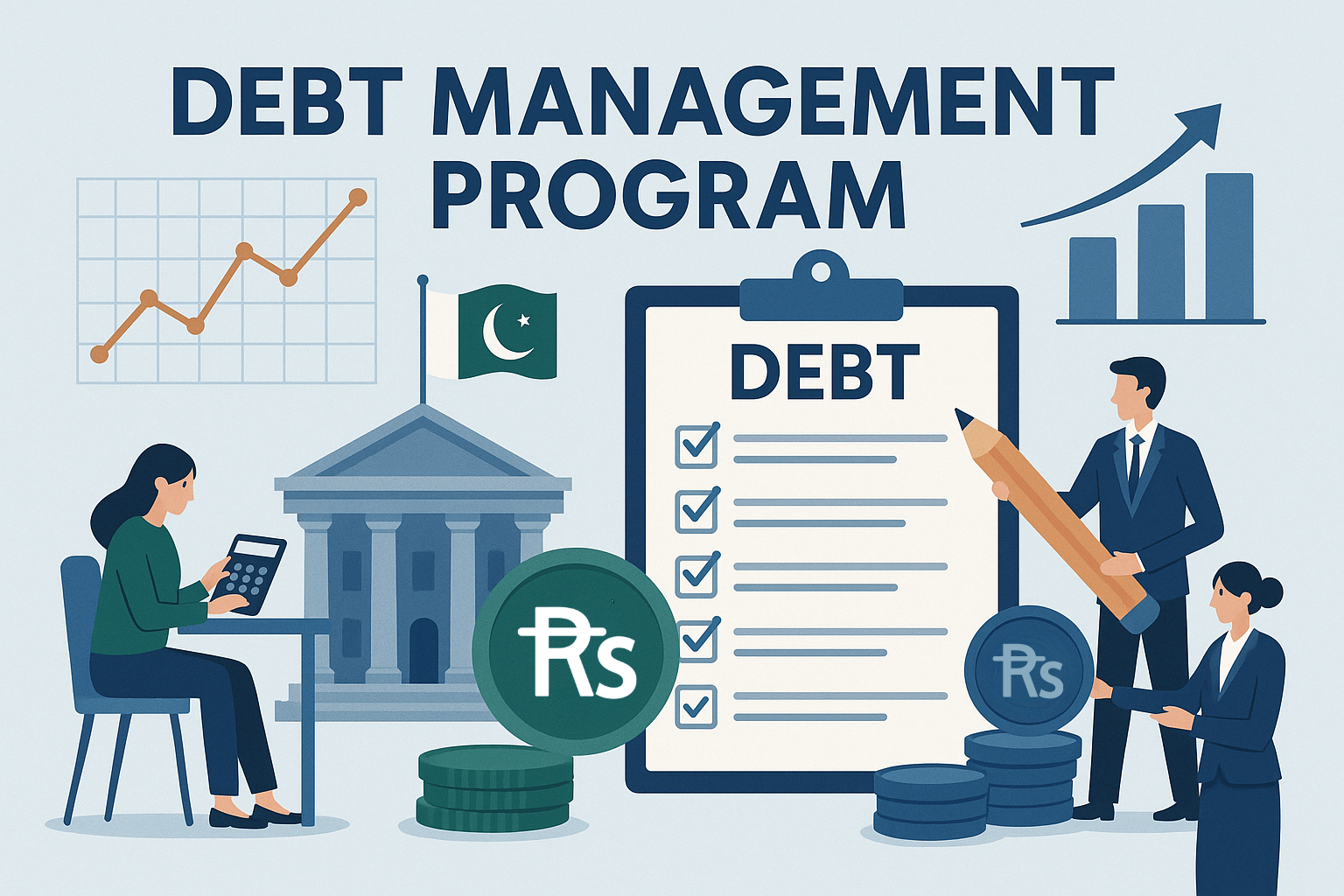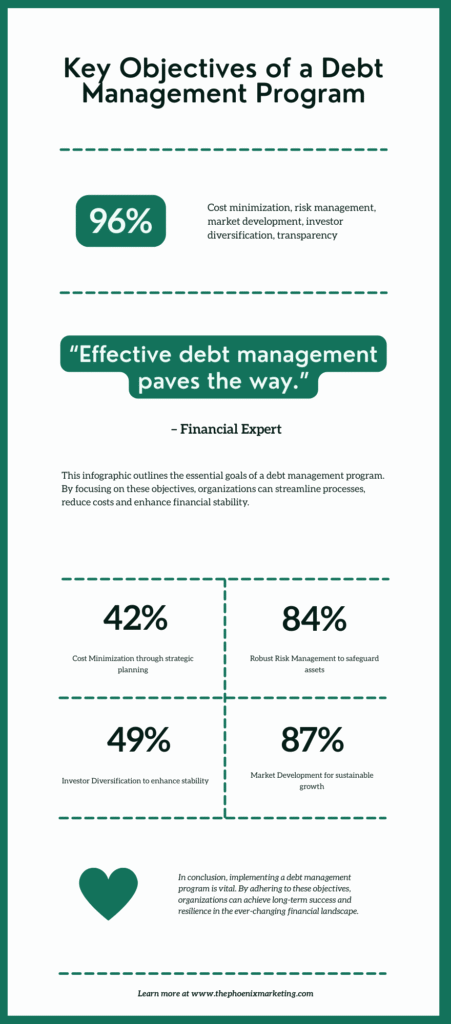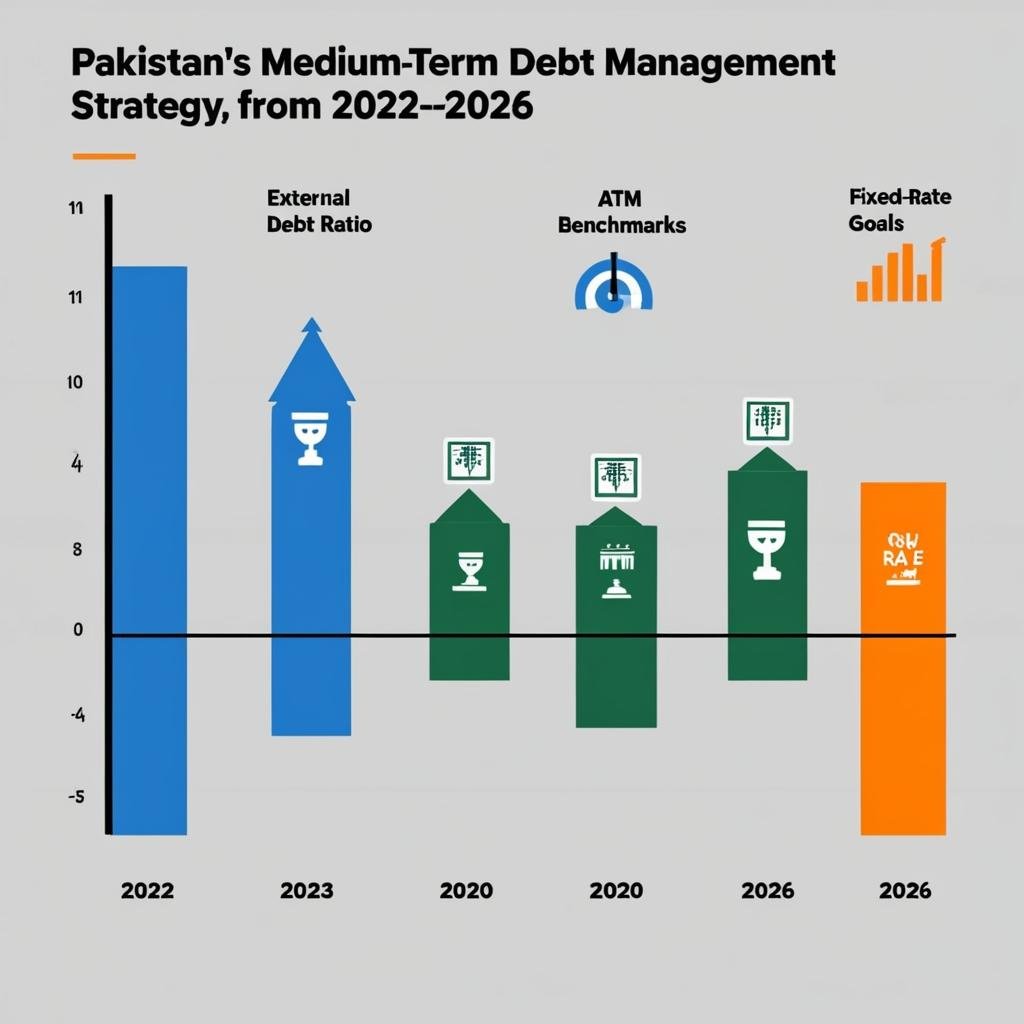What Is a Debt Management Program and How Does It Work in Pakistan’s Financial Strategy

1. Introduction
What is a debt management program? It’s a structured approach that enables governments to handle public borrowing and debt repayments efficiently. This program ensures a country remains financially stable, especially during economic challenges.
In developing nations like Pakistan, where borrowing is necessary to support infrastructure, defense, health, and education, managing that debt becomes crucial. Pakistan’s strategy—formally known as the Medium-Term Debt Management Strategy (MTDS)—focuses on maintaining a healthy balance between debt cost and risk. It also aims to foster growth in the domestic capital market and ensure that debt obligations are met without compromising long-term financial health.
Debt management isn’t just about paying back loans; it’s about how a country borrows, when, and under what conditions. These decisions directly impact inflation, interest rates, and even currency stability. Understanding debt management is just one part of financial planning. If you want to explore how financial strategies begin, check out our detailed guide on what is Budgeting?
2. What Is a Debt Management Program
What is a debt management program? At its core, it is a government-led initiative designed to strategize and regulate the acquisition and repayment of public debt.
In Pakistan, this is manifested in the MTDS—an in-depth, medium-term plan that serves as a blueprint for managing the nation’s debt from fiscal years 2022/23 to 2025/26. Unlike ad hoc borrowing decisions, this strategy is rooted in data, risk analysis, and fiscal projections. It incorporates all forms of debt: domestic, external, on-lent to provinces, and IMF support for the budget.
This program provides policymakers with a roadmap to achieve economic resilience while ensuring that debt accumulation does not compromise the country’s financial sovereignty or overburden future generations.
3. Key Objectives of Pakistan’s Debt Management Program
What is a debt management program? In Pakistan, it’s defined by specific, measurable goals aimed at improving debt sustainability and market confidence.

3.1. Reducing Borrowing Costs and Managing Financial Risk
Debt carries both a financial cost (interest) and a set of risks (like inflation or currency depreciation). MTDS aims to minimize these costs over the medium to long term by choosing instruments and sources of funding that offer favorable terms while protecting against financial shocks.
3.2. Stimulating the Domestic Debt Market
A strong local bond market can provide governments with a stable, low-cost source of funding. Pakistan’s MTDS includes the development of instruments like Treasury Bills and Pakistan Investment Bonds with varying tenures to attract a broad range of investors.
3.3. Expanding and Diversifying Investor Base
Attracting a mix of investors—domestic, foreign, institutional, and retail—reduces concentration risk and improves liquidity. Special attention is given to Shariah-compliant investors through Sukuks and to ethical investors via ESG bonds.
3.4. Enhancing Fiscal Transparency
Transparent communication with stakeholders ensures credibility. Regular publications, clear auction schedules, and performance metrics are all part of the program’s communication strategy.
4. Strategic Guidelines and Implementation
What is a debt management program? It’s also about execution—using tools and policies to turn strategy into action.
4.1. Domestic Debt Approach
Pakistan aims to lengthen the maturity profile of its domestic debt by increasing the issuance of long-term instruments. Short-term debt, though easier to manage in the short run, increases refinancing risks. The program promotes fixed-rate borrowing to shield against rising interest rates, which could otherwise balloon the government’s repayment burden.
4.2. External Debt Strategy
The external portion of debt is focused on securing concessional loans from international institutions like the World Bank, Asian Development Bank, and bilateral donors. These come with lower interest rates and longer maturities, helping stabilize external obligations.
Pakistan also maintains a presence in the international capital markets via instruments like Eurobonds and Sukuk. New initiatives like green and ESG bonds are designed to attract socially responsible investors.
4.3. Financial Resilience Tools
The MTDS includes provisions for maintaining a revolving liquidity buffer, which serves as insurance against temporary market shocks or refinancing challenges.

5. Scope and Limitations of the MTDS
What is a debt management program? It has defined boundaries to maintain focus and effectiveness.
5.1. What’s Included
- All federal government debt, including on-lent debt to provinces and public enterprises.
- IMF financing for budgetary purposes.
5.2. What’s Excluded
- IMF debt for balance of payments support.
- Private sector and provincial government borrowings.
5.3. Limitations
- Vulnerability to macroeconomic variables such as inflation, exchange rate fluctuations, and fiscal deficits.
- Dependency on GDP growth to ensure debt servicing remains manageable.
- Exposure to political changes can disrupt implementation.

6. Performance Evaluation (2019/20 – 2021/22)
What is a debt management program? Its success can be gauged through historical performance.
6.1. Milestones Achieved
- Strategic benchmarks were largely met.
- Sukuk bonds issuance exceeded targets, reflecting a strong market response to Islamic instruments.
- Gross Financing Needs (GFN) reduced significantly to 26% of GDP.
6.2. Areas of Underperformance
- Average Time to Maturity (ATM) declined due to increased short-term borrowing needs.
- Fixed-rate debt share dropped as the government pivoted to floating-rate instruments in response to global interest rate hikes.
6.3. Lessons and Adjustments
- Need for better buffer mechanisms against natural disasters like floods.
- The greater importance of economic diversification to withstand commodity price volatility.
7. Forward-Looking Targets (FY 2022/23 – 2025/26)
What is a debt management program? It involves planning to mitigate risks and capitalize on growth.
| Metric | Target by 2026 |
| External Debt Share | Max 40% of Total Public Debt |
| Domestic ATM | Min 3 Years |
| External ATM | Min 6 Years |
| Shariah-Compliant Instruments | 15% of Government Securities |
| Fixed-Rate Debt | At Least 20% |
| Gross Financing Needs (GFN) | Max 35% of GDP |
These targets are designed to reduce rollover risk, strengthen investor confidence, and align Pakistan’s debt profile with international best practices.
8. Rationale Behind the Strategic Targets
What is a debt management program? It’s grounded in sound economic logic.
8.1. Currency and Refinancing Risk Management
By capping external debt and prioritizing longer maturities, Pakistan shields itself from exchange rate volatility and frequent refinancing.
8.2. Enhancing Market Confidence
Maintaining a robust fixed-rate debt share provides predictability in debt servicing, which is crucial for market confidence, especially in volatile global conditions.
8.3. Strengthening Islamic Finance
Pakistan’s emphasis on Sukuk aligns with its large Muslim population and growing demand for Shariah-compliant investment products.
9. Conclusion
What is a debt management program? It’s a multidimensional strategy to ensure that public borrowing is sustainable, strategic, and secure. Pakistan’s MTDS serves as a critical financial tool designed to stabilize the economy, deepen financial markets, and align public finance with long-term development goals.
With clear objectives, diversified instruments, and defined targets, Pakistan is not only managing its debt but also reshaping the financial infrastructure to be more resilient, inclusive, and future-ready.
Frequently Asked Questions (FAQ’s)
- What is the main goal of a debt management program?
To manage a country’s borrowing in a way that minimizes cost and risk while supporting fiscal and economic goals. - How does MTDS help Pakistan’s economy?
By ensuring that debt remains affordable and manageable, it reduces financial stress on future budgets. - What are ESG bonds?
These are “Environmental, Social, and Governance” bonds aimed at ethical investors who prioritize sustainability. - Why issue Sukuks instead of conventional bonds?
Sukuks cater to Islamic investors and diversify the government’s investor base, often at lower costs. - Can MTDS be adjusted?
Yes, it is reviewed annually and can be adjusted based on market conditions, economic shifts, and global trends.





